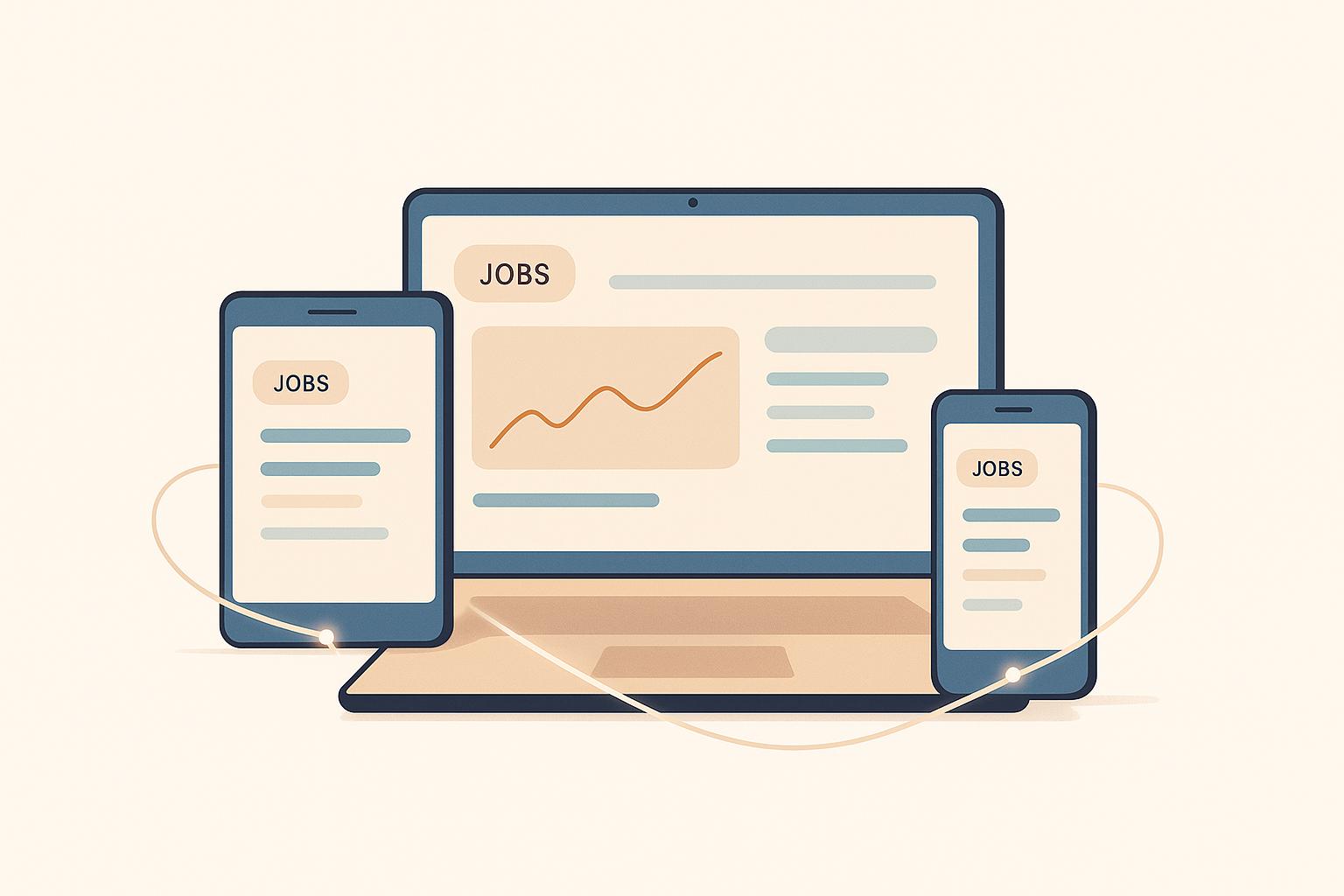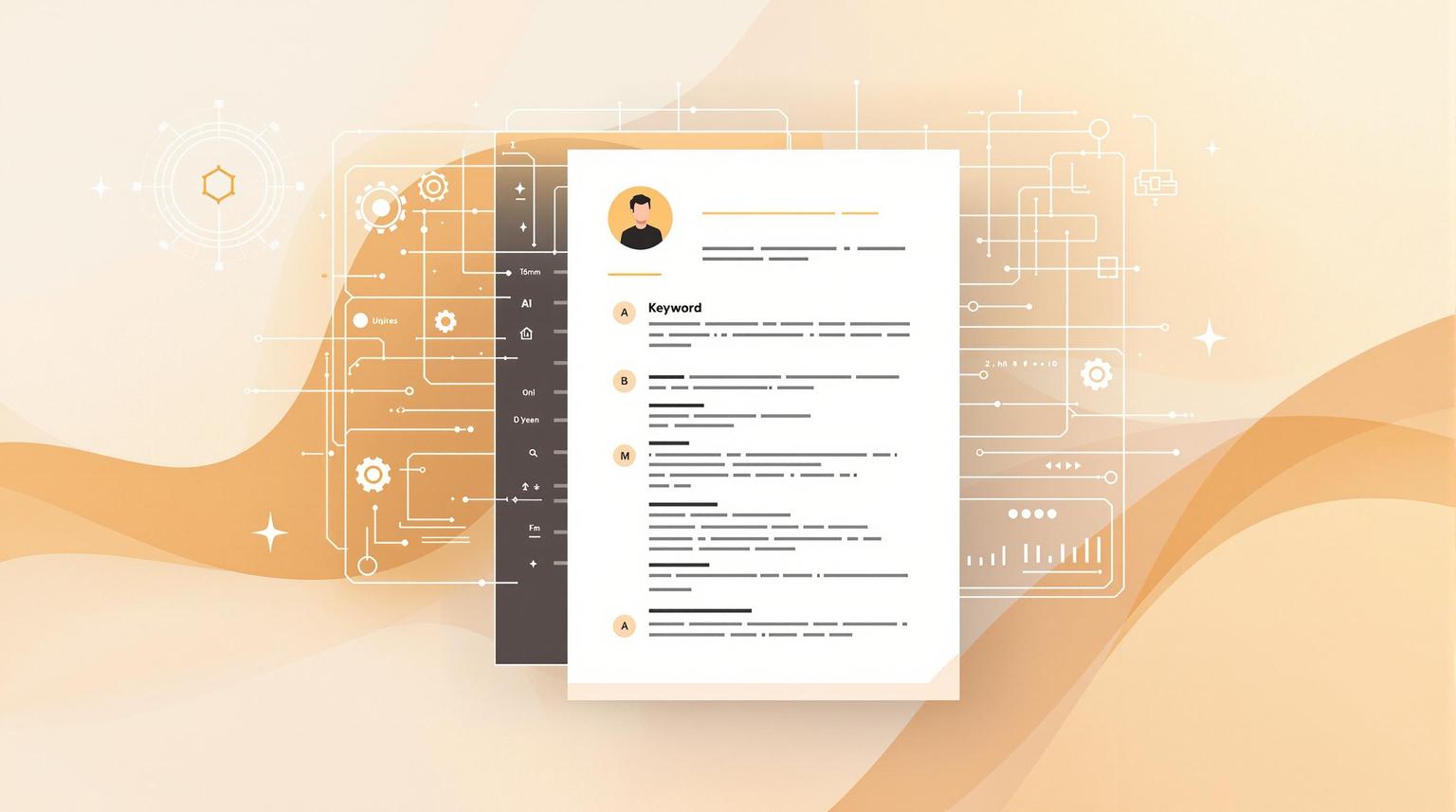AI is transforming how job seekers and employers connect by analyzing resumes and job postings to match skills with market demands. Here's a quick breakdown of how it works:
- Skills Analysis: AI tools use Natural Language Processing (NLP) to extract and interpret skills, certifications, and experience from resumes and job descriptions.
- Matching Algorithms: Machine Learning (ML) pairs candidates with roles based on skill relevance, experience levels, and industry needs.
- Market Insights: AI tracks trends like emerging skills, sector growth, and regional job demands to guide career planning.
- Job Search Tools: Platforms like JobSwift.AI offer features such as resume optimization for ATS, scam detection, and application tracking to simplify the job search process.
- Ethics and Security: AI ensures fairness by avoiding bias and protecting personal data in job applications.
Job Skills Match using AI (ChatGPT)
AI Skills Analysis Methods
Text Analysis and Resume Reading
AI systems use Natural Language Processing (NLP) to analyze both structured and unstructured data from resumes and job descriptions. By examining word patterns, context, and relationships, these systems extract detailed information about skills. Unlike basic keyword matching, NLP dives deeper to interpret semantic connections and professional expertise.
Some key capabilities of modern NLP algorithms include:
- Identifying explicit and implicit skills: Extracting skills from job descriptions and work experience sections.
- Recognizing industry-specific terms and certifications: Understanding niche language and qualifications.
- Mapping skill relationships: Highlighting how skills are connected or ranked in importance.
- Assessing skill levels: Detecting indicators of proficiency or expertise.
For instance, JobSwift.AI uses NLP to optimize resumes, ensuring they meet Applicant Tracking System (ATS) standards. This approach provides sharper insights, making skills matching more accurate.
Skills Matching Algorithms
Machine Learning (ML) algorithms pair job requirements with candidate qualifications by analyzing multiple data points:
- Skill relevancy scoring: Assigning importance to skills based on their role-specific value.
- Experience level evaluation: Reviewing how recently and deeply a skill has been applied.
- Industry context understanding: Translating skills across various sectors.
- Role-specific alignment: Matching candidates' abilities to specific job needs.
These algorithms go beyond simple keyword matching, interpreting the complex relationships between skills, roles, and industries. This results in better candidate-job alignment, reducing mismatches during hiring. Additionally, AI considers broader trends, offering a more comprehensive view of labor market dynamics.
Market Trends and Predictions
AI also tracks job market data to highlight emerging skills and predict future trends. These models focus on:
- Job posting analysis: Monitoring shifts in required skills across industries.
- Sector growth insights: Spotting expanding industries and their evolving needs.
- Technology adoption tracking: Observing how new tools and systems shape skill demands.
- Regional skill variations: Identifying geographic differences in workforce requirements.
This data-driven analysis gives job seekers a clear picture of which skills are becoming more relevant. It also helps professionals plan their career growth and focus on acquiring skills that align with market demands.
sbb-itb-96bfd48
AI Job Search Tools
Smart Job Matching
AI-driven job matching systems take a closer look at candidate profiles by assessing technical skills, certifications, soft skills, experience, and career growth. Instead of relying solely on keyword matches, these systems recommend roles that align with a candidate's qualifications. For example, a React developer might be matched with positions requiring expertise in JavaScript frameworks. This approach ensures a more accurate fit between candidates and job opportunities.
Skills Gap Detection
AI tools can compare a candidate's abilities with current market requirements, identifying areas that might need improvement. These tools highlight:
- Key skills missing for desired roles
- Gaps in knowledge about new technologies
- Certifications or training relevant to specific industries
- Experience levels that might need boosting
Armed with this information, job seekers can better plan their professional growth, whether through learning new skills or earning certifications. Alongside these insights, AI tools simplify the job application process, making the journey smoother.
AI Application Tools
AI doesn't stop at matching candidates to jobs - it also enhances the application process. Platforms like JobSwift.AI offer features designed to save time and improve efficiency:
| Feature | Benefit |
|---|---|
| Application Dashboard | Keeps all job applications organized in one place |
| Automatic Status Tracking | Tracks application progress automatically |
| Job Scam Protection | Filters out potentially fraudulent listings |
| AI CV Optimization | Adjusts resumes for better compatibility with ATS |
"The one click application feature is a game changer. I love JobSwift.AI!" - Crystal O'Connor, Job Seeker
JobSwift.AI's Pro plan, available for $39.99 per month, lets users submit up to 300 applications each month while keeping detailed application records.
Risks and Ethics
AI Bias Prevention
AI job-matching tools must actively avoid bias in their algorithms. This means ensuring they don't discriminate based on factors like age, gender, ethnicity, or other protected attributes. Modern systems are designed to evaluate candidates based on skills and qualifications, steering clear of personal characteristics.
Fake AI-generated resumes disrupt the job market and waste time for everyone involved. Instead of creating false credentials, job seekers should focus on presenting their genuine skills and experiences accurately.
Data Protection
Keeping personal information secure is a top priority for AI-powered job platforms. As job scams become more advanced, strong security measures are non-negotiable. For instance, JobSwift.AI takes several steps to enhance user protection:
| Security Measure | Purpose |
|---|---|
| Suspicious Activity Flagging | Spots potentially fraudulent job postings |
| Conversation Monitoring | Warns users about unusual communication patterns |
| Manual Application Control | Ensures personal data isn't submitted automatically |
| Scam Detection Systems | Filters out fake job listings before users can view them |
"We believe you should control where you apply to avoid sending your personal information to scammers on your behalf." - JobSwift.AI
Combining strong security protocols with human oversight makes these platforms more dependable and secure for users.
Human and AI Collaboration
AI brings speed and efficiency, but human involvement is essential to handle ethical concerns and uphold market standards. The best results in skills mapping come from combining AI's data-processing power with human judgment. While AI can analyze massive datasets and spot trends, humans ensure decisions are ethical and accurate.
Some key principles for effective collaboration include:
- Ethical Decision-Making: Humans should have the final say in job application reviews and candidate selections.
- Resume Verification: Prioritize improving authentic resumes instead of creating artificial ones.
- Human Oversight: Monitor AI recommendations to ensure proper implementation and maintain quality control.
The future of AI in job matching relies on striking the right balance between technology and human insight. By focusing on both efficiency and ethical practices, these systems can better support job seekers while preserving the integrity of the job market.
Conclusion: AI in Job Search
Main Points
AI tools are transforming how skills align with market demands, offering better matching, tracking, and safety. Platforms like JobSwift.AI showcase these advancements.
Here’s a breakdown of how AI improves job searching:
| Feature | Benefit |
|---|---|
| Skills Analysis | Automates CV updates for better compatibility with Applicant Tracking Systems (ATS). |
| Application Tracking | Centralized dashboards help you track all your job applications in one place. |
| Security | Protects against fake job postings and secures your personal information. |
| Efficiency | Saves time with features like autofill for application forms. |
| Market Insights | Uses data to provide feedback that makes your CV more effective. |
Next Steps in AI Job Matching
The next phase of AI in job searching focuses on refining tools like CV optimization to help candidates align their skills with what employers need.
To make the most of these tools, job seekers should:
- Focus on ATS-friendly CVs: Update your current resume to meet ATS requirements without adding unnecessary fluff.
- Use tracking tools: Take advantage of AI platforms to monitor your application progress and success rates.
- Protect your data: Ensure your personal information stays secure, even while using automated features.
The key to success is blending the efficiency of AI with careful human decision-making.


